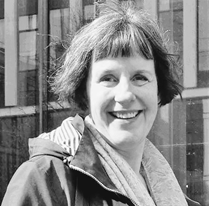
This fourth post in our five-part conversation, ‘Interdisciplinarity, reform, and the future of the University’, explores the connection between interdisciplinary education and real-world outcomes. With no alumni yet to point to, Edinburgh Futures Institute‘s (EFI) Interdisciplinary Futures programme team must rely on vision, research, and evolving labour market trends to make the case for employability. In this conversation with Anthony Skerik, Professor Sabine Rolle walks us through how the programme is preparing students for uncertain futures, and why those futures might demand a different kind of graduate. This post belongs to the ‘Navigating complexity through interdisciplinary teaching and learning‘ Hot Topic series.
The conversation
Anthony: Building off that last point about interdisciplinary depth, how do you reassure students who worry that an interdisciplinary degree might not be taken seriously by employers or postgraduate programmes?
Sabine: That’s a really important question, and also one of our ongoing challenges. Right now, one of the main issues is simply that we don’t yet have any graduates from this programme. We’ve only launched it recently, so our first cohorts are still working their way through it. That means we don’t yet have alumni we can point to and say, “Look where they’ve gone”, or invite back to speak with current students about their career paths. But that will come in time, and I’m confident we’ll build a strong network of graduates who’ll help us showcase the value of this kind of education in the real world.
In the meantime, we rely heavily on existing research—studies from academics as well as large organisations like the OECD—about the future of work. There’s a very consistent message across all this research: employers today, and even more so in the future, are looking for people who are adaptable, who can synthesise different perspectives, who can collaborate across teams, and who can handle uncertainty.
They want graduates who can listen to and integrate diverse viewpoints, work independently in unfamiliar territory, and learn quickly. And these are exactly the kinds of skills we aim to foster in our students. The world is increasingly unpredictable—just look at how fast industries are evolving. We can’t prepare students for one fixed role or trajectory anymore. What we can do is help them become the kinds of thinkers and collaborators who can thrive in environments that are constantly changing.
We also made employability a central concern from the very beginning of designing this degree. It wasn’t an afterthought—it was part of the programme’s foundation. We recognised early on that there are students looking for something different, but also employers looking for a different skillset—people who don’t just tick technical boxes, but bring agility, systems thinking, and creativity to their roles.
And while we wait for our own alumni success stories to emerge, we do point to general hiring trends. For instance, research shows that around 85% of job advertisements don’t specify a required discipline. They’re open to applicants from a wide range of academic backgrounds. That tells us a lot: employers are increasingly less focused on what you studied and more on how you think, how you problem-solve, and how you work with others.
So we try to reassure students using all of that data and insight, but I fully understand that, for now, there’s still some anxiety. That’s only natural—this is a relatively new area, and our students are brave for choosing it. I really admire them for stepping into something less familiar and more open-ended.
In fact, I think the programme tends to attract a certain kind of student—someone with curiosity, an open mind, and a willingness to explore uncertainty. It takes a bit of courage to commit to a path that doesn’t offer the traditional signposts, but those qualities—curiosity, flexibility, and confidence in the unknown—are what make our students so well-suited to the future of work.
Anthony: I imagine that will be reassuring for prospective students, especially those still weighing up the risks and rewards of choosing a less traditional degree path. But it’s not just students asking questions. Some faculty I’ve spoken to have raised a different concern: while the Curriculum Transformation project is working to expand interdisciplinary initiatives, the simultaneous Portfolio Review process is calling for reductions in courses and programmes. Some see this as contradictory. How would you respond to that?
Sabine: That’s a very real concern right now, and it’s important to acknowledge that. But I think it’s crucial to separate that concern from the work we’re doing specifically at the Edinburgh Futures Institute. The issue you’re describing stems more broadly from university-wide Curriculum Transformation initiatives, and understandably, there are questions about how these overlapping changes fit together.
My perspective is that interdisciplinary working doesn’t necessarily take anything away from existing schools or programme portfolios. Instead, it has the potential to enrich them. Interdisciplinary initiatives open up opportunities for colleagues to reach different kinds of students and to present their research in new ways. For example, as part of Curriculum Transformation, we’ve launched a series of pilot “challenge courses” that are radically interdisciplinary. These are thematic courses, often aligned with the University’s core research themes and missions, areas like sustainability, data ethics, and global health.
These courses give students access to cutting-edge research from across the University, but they also give faculty members a platform to showcase their own interdisciplinary research. Many colleagues working in complex research areas don’t typically have the opportunity to present their work to undergraduates, especially students from outside their own discipline. Through these courses, they can do just that, and the response so far has been really positive. Faculty are finding it enriching to engage with students from different backgrounds and to answer questions that challenge them in new ways.
So I always try to frame it not as a competition with single-discipline teaching, but as a complementary space. We are not replacing traditional disciplines; we’re expanding the space in which they can operate. Of course, the Portfolio Review is prompting all schools to reflect on their programmes and think critically about future direction. But those conversations are happening at the school level, as they always have, and they’re important for keeping subject areas up to date and responsive to developments in their fields.
Yes, it may feel like more of these conversations are happening now, all at once, but that doesn’t mean they’re at odds with interdisciplinary efforts. There is—and must be—space for both. Institutions like ours can and should support the coexistence of deep disciplinary work and interdisciplinary collaboration.
Anthony: That really helps put things in perspective. It’s encouraging to see that interdisciplinarity isn’t about replacing the old, but expanding what’s possible within and beyond it.
Next time in Part 5…
Anthony: As this post makes clear, interdisciplinary education isn’t about rejecting tradition; it’s about preparing students to navigate a world where tradition alone is no longer enough. Employers increasingly value skills like critical thinking, adaptability, and systems literacy—skills that programmes like Interdisciplinary Futures are purpose-built to foster.
And yet, without alumni case studies or long-standing reputations to lean on, EFI must make the case for this model in real time, drawing on global research, employer trends, and student courage. It’s a balancing act between vision and validation.
In our final post, we step back to consider the institutional terrain that makes—or breaks—the future of this kind of education. What needs to change, and who needs to be convinced, for interdisciplinarity to move from the margins into the mainstream?
 Anthony Skerik
Anthony Skerik
Anthony Skerik is a student at the University of Edinburgh and a member of the inaugural Interdisciplinary Futures class of 2027. His work explores how interdisciplinary thinking can be applied to real-world challenges, with a particular interest in conflict, innovation, and co-creation. He has held multiple positions within the University’s Information Services Group (ISG), supporting projects that bridge technology, communication, and education. As a co-editor of the Navigating Complexity: Preparing for the Future through Interdisciplinary Education blog series, he is committed to highlighting student perspectives and documenting the evolving landscape of interdisciplinary learning.
 Sabine Rolle
Sabine Rolle
Sabine Rolle is based in the Department of European Languages and Cultures (LLC) but currently does all her teaching through EFI, on the MA (Hons) Interdisciplinary Futures and the electives offered by EFI to students from across the university. Her strong interest in interdisciplinary education is also put to use in the role she plays leading on the development of cross-School Challenge Courses, as part of the Curriculum Transformation Programme and the implementation of the Learning and Teaching Strategy 2030.


